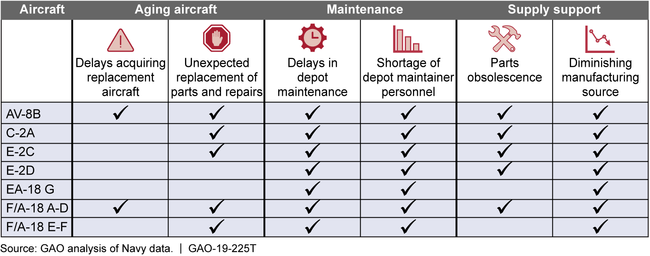Navy and Marine Corps: Rebuilding Ship, Submarine, and Aviation Readiness Will Require Time and Sustained Management Attention
Fast Facts
Since 2015, we have made 45 recommendations to help the Navy and Marine Corps ensure they have the personnel and equipment they need to be ready for their operations. We discussed the two services' readiness challenges in this testimony, including
Personnel shortfalls and gaps in experience leading to high sailor workloads
Maintenance delays that prevent ships and submarines from operating
Unavailable aircraft in both the Navy and the Marine Corps
While the services have taken initial steps to rebuild military readiness, fully addressing these challenges while balancing high demands will require years of sustained attention.
Two Aircraft Carrier Strike Groups Operating in the Pacific

Aerial photo of aircraft carriers and support out in open water
Highlights
What GAO Found
The Navy has taken steps to address training shortfalls in the surface fleet, but faces persistent maintenance and personnel challenges as it seeks to rebuild ship and submarine readiness. While the Navy has corrective actions underway, they will take years to implement. Following ship collisions in 2017, the Navy has taken steps to ensure its crews are trained to standards prior to deployment and made significant progress in those efforts. However, the Navy has struggled to complete ship maintenance—with only 30 percent of maintenance completed on time since fiscal year 2012—leading to thousands of days that ships were unavailable for training and operations (see figure). Additionally, manning shortfalls and experience gaps continue to contribute to high sailor workload and are likely to continue through at least fiscal year 2021. The Navy has developed a plan to improve shipyards and is re-examining its ship manning, among other actions; however, these positive steps have not yet fully addressed GAO's recommendations. Looking to the future, the Navy has indicated that it wants to grow its fleet to meet demands. However, the costs of such growth are not yet known and would likely require resourcing well above currently planned levels.
Days of Maintenance Delay by Type of Ship, Fiscal Years 2012 through 2018

Navy and Marine Corps aircraft availability has been limited due to numerous challenges (see figure). Specifically, the seven aircraft GAO reviewed have generally experienced decreasing availability since fiscal year 2011 and did not meet availability goals in fiscal years 2017 and 2018. The F-35—the future of naval aviation—also has not met availability goals due to part shortages and poor sustainment planning. In September 2018, the Department of Defense established aggressive targets for aircraft availability. While the Navy and Marine Corps are taking actions to improve aircraft availability, including addressing GAO's recommendations, aviation readiness will take many years to recover.
Sustainment Challenges Affecting Selected Navy and Marine Corps Aircraft

Why GAO Did This Study
The 2018 National Defense Strategy emphasizes that restoring and retaining readiness is critical to success in the emerging security environment. The Navy and Marine Corps are working to rebuild the readiness of their forces while growing and modernizing their aging fleet of ships and aircraft. However, achieving readiness recovery goals will take years as both services continue to be challenged to rebuild readiness amid continued operational demands.
This statement provides information on current and future readiness challenges facing (1) the Navy ship and submarine fleet and (2) Navy and Marine Corps aviation. GAO also discusses prior recommendations on Navy and Marine Corps readiness and progress to address them.
This statement is based on previously published work since 2015 related to Navy and Marine Corps readiness challenges, including shipyard workforce and capital investment, ship crewing, weapon system sustainment, the fighter pilot workforce, and modernizing force structure. GAO conducted site visits to the Pacific fleet in November 2018 and analyzed updated data, as appropriate.
Recommendations
GAO has made a total of 45 recommendations in the prior work described in this statement. The Department of Defense concurred with most of them, and has many actions underway, but has not yet fully implemented any. Attention to these recommendations can assist the Navy and the Marine Corps as they seek to rebuild the readiness of their forces.
